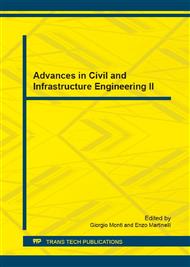[1]
Xiao, Y., Shan, B., Chen, G., Zhou, Q. and She, L.Y. (2007). Development of A New Type of Glulam – GluBam, Modern Bamboo Structures, Xiao et al. edited, Proceedings of First Int. Conf. of Modern Bamboo Structures 2007, CRC Press, UK, 299 p.
DOI: 10.1201/9780203888926.ch5
Google Scholar
[2]
Xiao, Y., Yang, R. Z., and Shan, B. (2012). Experimental research on mechanical properties of GluBam [J]. Journal of Building Structures, 33(11), 150-157.
Google Scholar
[3]
Xiao, Y. and Shan, B. (2013). GluBam Structures [M]. Beijing: China Architecture & Building Press.
Google Scholar
[4]
Yeoh, D., Fragiacomo, M., and Franceschi, M.D. (2011). State of the art on timber-concrete composite structures: literature review [J]. Journal of Structural Engineering, 10, 1085-1095.
DOI: 10.1061/(asce)st.1943-541x.0000353
Google Scholar
[5]
Ceccotti, A. (1995). Timber-concrete composite sturctures [C]. Timber engineering STEP2, Blass H., et al., ed., 1st Ed. , Centrum Hout, Netherlands, E13/1-E13/12.
Google Scholar
[6]
Coluston, P., Bathon, L. and Schreyer, A. (2005). Shear and bending performance of a novel wood-concrete composite system [J]. Journal of Structural Engineering, 131(9): 1404-1412.
DOI: 10.1061/(asce)0733-9445(2005)131:9(1404)
Google Scholar
[7]
Brunner, M., Romer, M. and Schnurger, M. (2007). Timber-concrete composite with an adhesive connector (wet on wet process) [J]. Materials and Structures, 40(1), 119-126.
DOI: 10.1617/s11527-006-9154-4
Google Scholar
[8]
Lukaszewska, E., Johnsson, H. and Fragiacomo, M. (2008). Performance of connections for prebricated timber-concrete composite floors [J]. Materials and Structures , 41(9), 1533-1550.
DOI: 10.1617/s11527-007-9346-6
Google Scholar
[9]
Grantham, R., Engily, V., and Fragiacomo, M. (2004). Potential upgrade of timber frame buildings in the UK using timber-concrete composite [C]. Proceedings of 8th World Conference on Timber Engineering, Vol. 2, Lathi, Finland, 59-64.
Google Scholar
[10]
Ceccotti, A., Fragiacomo, M. and Giordano, S. (2006). Long-term and collapse tests on a timber-concrete composite beam with glued-in connections [J]. Materials and Structures, 40(1), 15-25.
DOI: 10.1617/s11527-006-9094-z
Google Scholar
[11]
Gutkowski, R., Rrown, K., and Shifidi, K. (2008). Laboratory tests of composite wood-concrete connections [J], Construction and Building Materials, 22(6), 1059-1066.
DOI: 10.1016/j.conbuildmat.2007.03.013
Google Scholar
[12]
Kenel, A. and Meierhofer, U. (1998). Long-term performance of timber concrete composite sturctural elements [R]. Report No. 115/39, EMPA Abteilung Holz, Dubendorf, German.
Google Scholar
[13]
Yeoh, D. (2010). Behaviour and design of timber-concrete composite floor system [D], Ph.D. thesis, University of Canterbury, New Zealand.
Google Scholar
[14]
Fragiacomo, M., Amadio, C. and Macorini, L. (2004). A finite element model for collapse and long-term analysis of steel-concrete composite beams [J]. Journal of Structural Engineering, 130(3), 489-497.
DOI: 10.1061/(asce)0733-9445(2004)130:3(489)
Google Scholar
[15]
To, L.G. 3D finite element modelling of time-dependent behavior of wood-concrete composite beams. Ph.D. thesis. Colorado State Univ., Fort Colin, CO.
Google Scholar
[16]
Committee European Normalisation. (1991). Timber structures joints made with mechanical fasteners – General principles for the determination of strength and deformation characteristics [S]. EN 26891, Brussels, Belgium.
DOI: 10.3403/00248652
Google Scholar


